AFRICA
Chameleons for Conservation: Surveys and Monitoring in the Menabe Region, Madagascar (2006)
Project leader Christian Randrianatoandro presented the rationale, methods, objectives and background of the chameleon conservation project at the annual meeting of the Menabe Research Group (GRM) in March 2006. This group is comprised of conservation organisations and national or international researchers working in the Menabe Region.
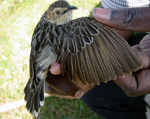 Ecology and Conservation of Aberdare cisticola in the Mau Narok-Molo Grasslands, Kenya (2006)
Ecology and Conservation of Aberdare cisticola in the Mau Narok-Molo Grasslands, Kenya (2006)
The team set out in July to survey the status of the Aberdare cisticola, a globally endangered bird species that inhabits moist highland grasses in the Aberdare Mountains of Kenya. The was recorded in grassland patches surrounded by cultivated land and is greatly isolated from other grasslands.
Operation Moheli, Comoros (2006)
Operation Mohéli was launched in May to link conservation of marine flagship species with sustainable development. The team is currently visiting all villages within the Mohéli Marine Park, presenting the objectives of the project, assessing opportunities for ecotourism and perceptions of the marine park, and distributing dugong sighting cards.
Ecology, Distribution, Status and Protection of Three Congolese Fruit Bats, DRC (2005)
In September and October of last year the team conducted research aimed at finding three species of fruit bat (Megachiroptera) in the southwest of the Democratic Republic of Congo and of the Republic of Congo: Epomophorus grandis, Micropteropus intermedius and Epomophorus cf. labiatus. After intensive fieldwork, neither species has been found. But, the results of the project indicate that the diversity of Megachiroptera in the two regions may still be relatively rich.
Project Yabelo: Status of the Ethiopia Bush Crow and White-tailed Swallow, Ethiopia (2005)
From the data collected by the Bushcrow project in Ethiopia, it is hard to give precise trends of either the Ethiopian Bushcrow Zavattariornis stresemanni or White Tailed Swallow Hirundo megaensis populations. However, both were seen on a regular basis the Bushcrow daily and in relatively large numbers.
Rainforest Reserves for Critically Endangered Comorian Fruit Bats (2005)
The Fruit Bat team has been hard at work analyzing data and developing a draft plan for establishing small community-managed forest reserves in the Comoros. Results are proving quite interesting based on social surveys in villages and ecological surveys in forests, they have been able to evaluate potential reserve sites based upon conservation value, threats from human encroachment, and the feasibility of establishing reserve sites.
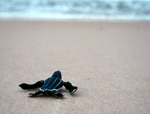 Threats to Nesting Leatherback Turtles in Pongara National Park, Gabon (2005)
Threats to Nesting Leatherback Turtles in Pongara National Park, Gabon (2005)
One of the major threats to nesting sea turtles, particularly in northern Gabon, is timber littering the beaches. Timber companies often float logs down the rivers. During these operations, they occasionally escape and are swept to sea. Subsequently, many logs wash up on shore, littering beaches and creating a serious threat for nesting sea turtles and emerging hatchlings.
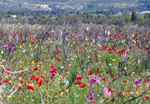 Tulbagh Renosterveld Project, South Africa (2005)
Tulbagh Renosterveld Project, South Africa (2005)
In August 2006 the conservation community came together to participate in the Fynbos Forum an annual conference where researchers, conservationists and communities present their work, network and share lessons learned. As a side trip, the team took a group of 75 participants to a farm identified as a top priority for conservation in the Tulbagh Valley where they saw an amazing blanket display of ruby red Babiana villosa and Geissorhiza inflexa.
Bat Conservation, Madagascar (2004)
The team is continuing their radio tracking projects on the Madagascar flying fox Pteropus rufus and trident nosed bats Triaenops rufus and T. furculus. These field studies are aimed at describing the landscape ecology of the bats and will help increase understanding of the relationship between foraging and roosting sites.
Mpingo Conservation Project, Tanzania (2004)
The Mpingo Conservation Project aims to conserve the over-exploited mpingo forests in Tanzania by promoting sustainable and socially equitable harvesting of the Mpingo and other valuable timber stocks. In July, the first village forest management plan was approved by the district council, meaning that Kikole villagers can now start to manage their own forest area.
Yala Management Team, Kenya (2003)
The Yala Swamp Management Team, a group of young conservationist and scientists that won a BP Conservation award in 2003, continues to work hard for the conservation and sustainable utilization of the Yala swamp. Under a government registered Natural Resources Management Group (NARE-SK), the team is collaborating with other partners in campaigning for better utilization of the wetland for sustainable development and biodiversity conservation.
Studying the Impacts of Plant Exploitation on Habitat and Gorilla Populations, DRC (2001)
The aim of the project is to protect the Itombwe Forest Ecosystem and its biodiversity. The Itombwe forest, located in the South Kivu Province, Eastern DR Congo in the Albertine Rift, is recognised by BirdLife International as a priority area for conservation considering its rich biodiversity and endemism.
Read more about projects in Africa...
ASIA / PACIFIC
Bat Count Philippines (2006)
In June, Bat Count Philippines participated in the 10th Mudpack Festival of Mambukal in collaboration with the local government unit of Minoyan, Murcia, Negros Occidental and FFI - Philippine Biodiversity Conservation Programmes and its Mobile Education Unit. The week long activity commemorates the on-going festival tradition in the area.
Conservation Status of the Montaine Slender Loris, Horton Plains National Park, Sri Lanka (2006)
The principle objective of this project is to provide baseline data to initiate an effective long-term conservation program for the Montaine Slender Loris, a small nocturnal prosimian primate endemic to Sri Lanka and South India.
Javan Slow Loris Project, Gunung Gede Pangrango National Park, Indonesia (2006)
The Javan Slow Loris Nycticebus javanicus is the only nocturnal prosimian endemic to Java. Despite it being severely threatened by hunting, deforestation and the pet trade, the lack of information about its demography and ecology prohibit the development of strategies to conserve and protect it. This project is a first step to initiate a long-term and comprehensive conservation program for the Javan Slow Loris.
Small Carnivore Conservation in the Mekong Delta, Vietnam (2006)
In August, the team conducted a field skills training course on Small carnivores in Cat Tien National Park and plans to select two students from the training to join the team as they conduct field surveys in the Uminh area/Mekong Delta.
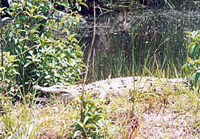 CROC Project, Philippines (2005)
CROC Project, Philippines (2005)
Every two years the IUCN Crocodile Specialist Group presents the Castillo Cup Award to people who have made an outstanding contribution to crocodile conservation. During the farewell dinner, the team was caught by surprise when the chair of the specialist group, Dr. Graham Webb, called them on stage to receive the 2006 Castillo Cup!
Extending Chelonian Research, Education and Conservation, Cambodia (2005)
The Cambodian Turtle project is conducting research on endangered turtles in unstudied areas, educating local children and adults in important conservation areas, and training government rangers to enforce wildlife laws and release confiscated turtles in suitable sites and habitats.
Calayan Rail: Conservation of an Island Endemic, Philippines (2005)
The aim of the Calayan Rail project was to initiate a long-term program for conservation of this bird and other wildlife and natural habitats of Calayan Island, and numerous activities have taken place to bring the group closer to that goal, including field surveys, teacher training workshops, community consultations and outreach activities.
Behavioural Ecology and Conservation of Grey-Shanked Douc Langur, Vietnam (2004)
Project leader Ha Thang Long has continued his research on the the grey-shanked douc monkey in Kon Ka Kinh National Park and Kon Cha Rang Nature Reserve in Vietnam. His work will look at the behavioural ecology of two groups of grey-shanked douc langurs in different habitats to assess the conservation status of the species in each study site.
Action Tayam Peh, Nicobar Islands, India (2004)
This industrious team has achieved all the necessary data collection on the Nicobar Flying Fox and is now back from the field to carry out data analysis and report preparation work.
Population Status and Behaviour of Tonkin Snub-nosed Monkey, Vietnam (2004)
After completing the initial BP funded project, team leader Thanh Hai Dong has continued his research on the ecology and behaviour of Rhinopithecus avunculus at Khau Ca Tonkin Snub-nosed Monkey Conservation Area (TCA) for the past year.
Nepenthes, Indonesia (2001)
Bad news for this project! In mid-June, while monitoring Nepenthes sites in West Sumatra, the project team was surprised to find one of their sites severely degraded.
Read more about projects in Asia and the Pacific...
EURASIA
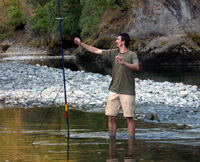 Sustainable Bat Conservation in the Caucasus Mountains (2006)
Sustainable Bat Conservation in the Caucasus Mountains (2006)
The overall goal of this project is to maintain the actual population level of cave dwelling bats across the study region. In June, the team began their summer fieldwork in Georgia and Armenia.
Supporting Conservation of the West Caucasian Tur, Georgia (2006)
The West Caucasian Tur is one of the most endangered and highly endemic species in the Caucasus. A lack of up-to-date data about the population status of this species has made it impossible to carry out conservation activities in the study area. This team hopes to resolve this problem!
Developing Conservation Measures for Darevsky's Viper, Armenia (2005)
In spring 2006, the team continued their field research on the critically endangered Darevskys Viper on the northwestern slopes of the Javakheti Ridge of Armenia.
Conservation of Globally Threatened Bird Species, Azerbaijan (2004)
After finalizing the 2004 project conserving globally threatened bird species in Azerbaijan, project leader Shahin Isayev secured a position with the Azerbaijan Ornithological Society as the IBA National Network Development Coordinator. He is currently working on establishing a network in Azerbaijan; the first stage of which was to select the 15 top priority IBAs.
Read more about projects in Eurasia...
LATIN AMERICA / CARIBBEAN
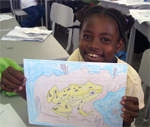 An Ecological Study of the Bloody Bay Poison Frog, Trinidad & Tobago (2006)
An Ecological Study of the Bloody Bay Poison Frog, Trinidad & Tobago (2006)
Mannophryne olmonae is a poorly studied and critically endangered frog species endemic to Tobago. This team is working to collect further data on this species and raise awareness to conserve frogs and their habitats in the region.
Conservation Status of Newly Rediscovered Southern Horned Curassow, Peru (2006)
The team set out to conduct field studies to locate and estimate the size of the surviving Peruvian Southern Horned Curassow population and determine its conservation requirements and vulnerability to human encroachment.
Assessment of Seabird Bycatch in Peruvian Artisanal Fisheries, Peru (2005)
In July, Pro Delphinus submitted a final report for their project Assessment of seabird bycatch in Peruvian artisanal fisheries. This research provides the first onboard observer based estimate of seabird bycatch in Peruvian artisanal fisheries.
Conservation of the Araripe Manakin, Brazil (2004)
In May 2006, the Araripe National Forest, one of the protected areas in the region that has great influence in the maintenance of Manakin habitat, celebrated 60 years. To mark the event, the group adopted the Araripe Manakin as its symbol, and, together with the postal services, launched a nationwide commemorative stamp with a picture of the Manakin.
Threatened Birds of Bolivia / Proyecto Aves Amenazadas de Bolivia (2004)
The last year has been a busy and successful one for the conservation of Bolivias threatened bird species. It started with a conservation funding workshop for young Bolivian biologists that aimed to provide training in how to successfully apply for international funds to start or develop conservation projects.
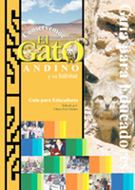 Community Participation for Long-term Conservation of the Andean Cat, Argentina (2003)
Community Participation for Long-term Conservation of the Andean Cat, Argentina (2003)
The Andean Cat project recently launched the EduGat Program to involve local communities in the conservation of the Andean cat in Argentina through a change in attitudes, an increase in ecological understanding and a search for sustainable, conservation-friendly uses of local resources.
Incidental Capture of Seabirds, Argentina (2003)
In the past nine months, the team completed 11 fishing days with 26 hauls recorded. The observations were made on board in vessels at Puerto Quequén, Buenos Aires Province.
A Unique Bird Habitat, Southeastern Cuba (2005)
The main goals of this project are to rediscover the Cuban kite and the Cuban parauque; to estimate the population size and distribution of the Cuban sparrow, Gundlachs hawk, the bee hummingbird, and the Cuban gnatcather in southeastern Cuba; and to improve the protected areas network.
Read more about projects in Latin America and the Caribbean...

